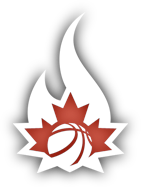Berlin Olympics a breakthrough for Canadian basketball
Posted on April 16, 2015
By Tony Atherton Postmedia News
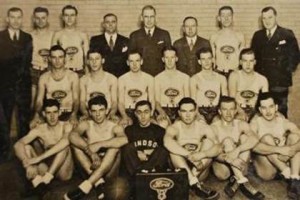
Seventy-five years ago Aug. 1, with a short proclamation and a Nazi salute, Hitler opened the 11th Olympiad of the modern era. Today those Games are largely remembered for the performance of Jesse Owens, the black U.S. track star who shattered 11 Olympic records – and the illusions of Aryan supremacy. But as Tony Atherton writes, a great unsung Canadian story was written in Berlin, a story involving a man with an idea and a peach basket from Almonte, Ont., and two Jewish kids from Windsor, Ont.
The airship Hindenburg, a fat silver stogie a quarter-kilometre long, hung above the crowd in a sky as grey and flat as slate. Its crew could look down and see the entire monumental sweep of the National Socialist German Workers’ Party’s overweening Olympic spectacle: the massive stadium now jammed with 110,000 spectators; the Maifeld, a 28-acre lawn capable of holding a quarter of a million people; the Dietrich Eckhart amphitheatre built into a natural ravine with seating for 20,000; the 77-metre Bell Tower, with a view that took in all of Berlin – plus playing fields, swimming pools, administrative offices. All new, all imposing, all designed to send a message that had little to do with Olympic ideals.
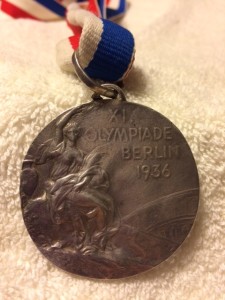
Most of the buildings were clad in limestone, buttressed by great columns, heavy with oversized cornices, and flanked by stone sculptures of graceless, thick-bodied athletes. The effect was undoubtedly striking, if bordering on oppressive, but the man upon whom all eyes in the stadium were fixed might have preferred the adjective “triumphal.”
“I proclaim the Games of Berlin, celebrating the 11th Olympiad of the modern era, to be open,” he said, standing in a reviewing stand built to his own specifications, proud in his jackboots, his unruly forelock, the absurd little moustache. And when he intoned those words, more than 100,000 arms jerked up in a stiff salute, more than 100,000 raucous voices screamed themselves a little more ragged. Like zealots, Toronto Star reporter Matthew Halton thought, looking on from the stadium press box. Like idolaters.
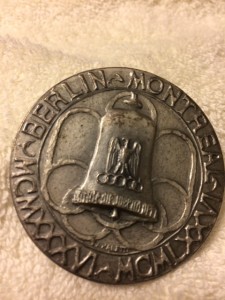
It was Aug. 1, 1936, 75 years ago, late in the afternoon. The day’s steady drizzle had not abated. The weather, it seemed, was the only thing in Germany yet to bend to the will of Fuehrer Adolf Hitler.
Down on the field, among the ranks of athletes from 52 nations, a skinny 24-year-old in a red blazer and white ducks, a Maple Leaf upon his breast, couldn’t keep an impish smile from spreading across his face. “He looks like Charlie Chaplin!” Toots Meretsky told himself. And no doubt felt better for it.
Toots was a Jewish kid from Windsor, Ont., standing in the heart of Nazi Germany, staring up at Hitler – on Shabbat, no less. He had passed ranks of crimson, swastika-emblazoned banners on his way into the arena. Now, he was hemmed in by an honour battalion of the German army. Everywhere he looked there were brownshirts, blackshirts, and blond, ecstatic Hitler Youth.
He knew of the systematic oppression of German Jews since the Nazis had come to power three years before. He knew about the boycotting of Jewish businesses, the revocation of citizenship, the edicts against intermarriage, not to mention the random vandalism, beatings, and intimidation.
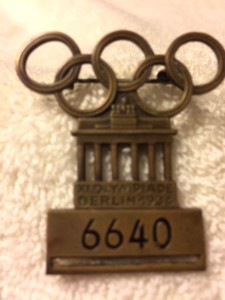
But Adolf Hitler looked like Charlie Chaplin. So Toots had to smile.
He was not alone. There were scores of other Jews scattered among the more than 4,800 athletes on the field, probably thinking similar thoughts. And there was one other close by, standing in the same tight rank of basketball players and coaches that had won the right to represent Canada in the sport’s debut at the Olympics.
Like Toots, Goldie Goldman had been instrumental in getting the Windsor-based team to Berlin. During a three-game sweep of the Canadian championship, Goldie had been one of the top scorers in two games. In the succession of tournaments leading up to national finals, he had been dominant in almost every match. Yet he knew before beginning the trip that he would not get to play in Berlin. He also knew he had to come anyway.
High in the stands, a silver-haired man in wire-rimmed glasses sought out the Canadian contingent on the field. A smile lifted the corners of his moustache. He was a few months shy of 75, and had come to the Games in no official capacity. Yet it might be said he had a greater stake in the upcoming tournament than any basketball player from the 22 nations that had fielded teams.
Forty-five years earlier, he had nailed a peach basket to the balcony of a YMCA gymnasium, and invited 18 exercise-averse commerce students to try a new indoor diversion. Now James Naismith had come to Berlin, travelling on meagre funds raised that spring in penny-drives at basketball games across North America. He had come to witness the apotheosis of his game.
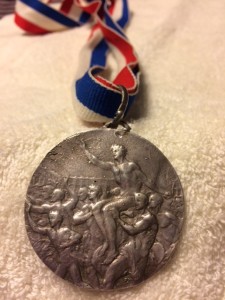
He had crossed the Atlantic with the American Olympic team, but his loyalties were divided. Naismith had lived and worked in the U.S. most of his life, but had been born and raised in small-town Ontario, and educated at McGill University in Montreal. He had put off becoming an American citizen until just a few years earlier. He hoped for a Canada-U.S. final. He wished both teams could win.
The clamour of the crowd pitched suddenly higher, and Naismith, Toots, Goldie, and the Fuehrer turned together to watch Siegfried Eifrig enter the stadium, holding high a slender torch manufactured by the Krupp armament company. As a sprinter, Eifrig hadn’t been fast enough to make the German track team but, clear-eyed and clean-limbed, he was eminently Aryan enough to be the last of 3,331 runners to carry the flame 3,187 kilometres from Olympia, Greece.
This “Olympic torch relay” was a heroic Nazi innovation that was meant, according to Carl Diem, secretary-general of the German Olympic Committee, to link the purity of ancient Greece with that of the new Aryan nation rising in Germany.
It was – like the smiling Wehrmacht officers acting as athlete “guides”, like the city streets assiduously stripped of anti-Semitic signs and publications, like the instructions to the German press not to be too effusive about German victories – a meticulously planned exercise in Nazi propaganda.
It was also, even for a Jewish basketball player from Windsor, impressive as hell.
One hundred and fifty years ago this November, Dr. James Naismith was born near Almonte, Ont. One hundred and twenty years ago in December, basketball was born in Springfield, Massachusetts. Seventy-five years ago this week, Naismith’s game had its international coming-out party at the most politically charged Olympic Games in modern history.
And on Aug. 14, 1936, Naismith himself presented the Canadian team with the country’s first – and only – Olympic medal in basketball. Among those honoured on a rain-soaked clay court beneath Olympic rings and Nazi swastikas, was forward Irving “Toots” Meretsky. Among those looking proudly on was the team’s assistant coach, Julius “Goldie” Goldman.
The “Nazi Games” are remembered largely for the glorious performance of black U.S. track star Jesse Owens, who won four medals and shattered 11 Olympic records – along with many illusions of Aryan supremacy.
But the story of how the Windsor Ford V8s, supplemented by some of the most legendary athletes in the annals of British Columbia sport, made Olympic and basketball history is Canada’s great unsung romance of the Berlin Games.
To appreciate the story, you have to realize that in the 1920s and ’30s, Windsor was a basketball dreadnought, the game’s hub in Canada. There are reasons for that.
When Naismith’s game went viral in the decade following its invention, no country adopted it more quickly, or more widely than Canada. It didn’t hurt that many of the phys-ed missionaries churned out in the 1890s by the Springfield YMCA Training Center were Canadians. They brought the game home from its birthplace and became basketball proselytizers at YMCAs, schools and youth clubs across the country. Including in Windsor.
“Windsor has been a hotbed of basketball in Canada for a long time,” says Paul Thomas, who coached the University of Windsor Lancers for more than 20 years beginning in the late ’60s. He was a player-coach on Canada’s 1952 Olympic team, also made up largely of players with Windsor ties.
Since Windsor is practically a suburb of Detroit, there was lots of high-level competition in the area from an early period, says Thomas. Basketball dynasties formed at the Windsor-Walkerville Technical School (later W.D. Lowe High School), Goldman’s alma mater, and at Assumption College, the Catholic institution that grew into the University of Windsor. Assumption was where Meretsky “majored in basketball” for two years, a Jewish kid coached by Basilian priests.
There were city teams, too, like the Windsor Alumni, made up of graduates from local high schools who didn’t want to stop playing. For years beginning in the 1920s, there was no one in Canada playing better ball than the boys from Windsor.
Then along came the Victoria Blue Ribbons, distilling more than three decades of basketball tradition in B.C.’s capital into one phenomenal team under the sponsorship of the Blue Ribbon Tea Co. In the early ’30s, coach Ernie Cook recruited former high school stars such as Art and Chuck Chapman, and a phenomenally talented 16-year-old named Doug Peden. They formed the core of what would become a legendary team.
In 1933, the Blue Ribbons upset the Windsor Alumni to take the first national basketball championship. In 1934, the teams met again in the final series and Windsor prevailed. The Blue Ribbons were back for the 1935 championship series, this time facing Windsor’s Assumption College and the squad known as the “Five Fighting Freshman,” which included future Olympians Meretsky and Stanley “Red” Nantais. Some called it the best team that ever came out of Windsor, but it couldn’t withstand the assault of the taller Blue Ribbons.
The stage was set for the 1935-36 season, the first year when a national basketball championship meant more than a couple of headlines in a local newspaper. The 1936 champ would play for Canada in the Berlin Olympics.
Few were surprised when the reigning national champs from Victoria, now renamed the Dominoes, won the western Canadian title for the fourth year running. But it wasn’t as obvious who would represent Eastern Canada – at least until Windsor’s city final series was played.
A new city team had formed that year consisting largely of former Assumption and Tech School players. They had convinced the city’s major employer, The Ford Motor Co., to underwrite expenses. Ford had recently become the first auto manufacturer to mass-produce V8 engines, so Windsor’s newest basketball powerhouse was called the Ford V8s.
Toots Meretsky was a V8, along with Nantais and local basketball stars like Ian Allison and Jimmy Stewart. Goldman, who had been playing and coaching across the river for Detroit Tech while earning a degree in electrical engineering, came back to Windsor to serve as captain.
In the middle of the Depression, Windsor was no more or less immune to anti-Semitism than any other part of Canada. But the fact that there were two Jews on the Ford V8s never seems to have been an issue with the players. “There seems to have been a lot of camaraderie on the team,” says Goldman’s daughter, Nancy Kushkin. “They all looked out for each other.”
The V8s had grown up playing with or against each other. They had been brought together by basketball; they gave little thought to what might set them apart.
In the city finals, the V8s squared off against an Assumption College team led by Bill “Moose” Rogin, another Jewish player who had been the top scorer for Assumption the year before, when Toots had been his teammate.
The series electrified the city. The teams traded wins back and forth over five games before the V8s finally prevailed. Though the Ottawa Rangers would take one game from the V8s in the Eastern Canada finals, no other series in the team’s march to the national title would prove so difficult as this first post-season matchup.
Goldman, who had been the V8s’ top scorer against Assumption, continued to lead the team in successive tournaments, while Meretsky proved unstoppable in the Ontario semifinals against the Niagara Falls Echoes.
The best-of-five Canadian championship series against the Victoria Dominoes in Windsor that April was almost anticlimactic; the V8s won in three straight, reclaiming the national title from their cross-continent rivals when it counted the most. They were going to Berlin.
But so were the Dominoes. Or at least some of them. The V8s lacked height and knew it was going to be their biggest problem in an international tournament. So they recruited the Victoria team’s biggest stars, Peden, a tough, physical player at six feet, and the Chapman brothers, both topping six-foot-two.
But the local press soon sniffed out a problem. Goldie Goldman, who had been such a big part of the V8s’ success, wasn’t eligible to play for Canada. Though he had been raised in Windsor from the age of two, and played almost all his basketball there, he had been born Mayesville, South Carolina. He was an American.
V8s manager Gordon Fuller was loathe to lose Goldman. He made some calls, the story goes. Some strings were pulled. Goldman was made an offer, recalls Kushkin.
“They said, ‘We can make you a Canadian this afternoon.’ And he said, ‘Yeah, but can you make me an American again.’ And of course they couldn’t. . . . He was not willing to give up his American citizenship.”
Instead Goldman agreed to accompany his team as an assistant coach. He had earned the right to go to Berlin, Fuller figured, even if he couldn’t play.
In none of the news reports leading up to the Games, however, did anyone ask Goldman or Meretsky what in retrospect seems an obvious question: How did they, as Jews, feel about going to Nazi Germany?
In the months before the Canadian championship, the threat of a U.S boycott of the Games had been quite real, thanks in large part to a vocal protest by the American Jewish Congress. Participation in the Games, it was argued, would give tacit support to the racist policies of the Nazi party.
Nazi propaganda minister Joseph Goebbels, who worried that a U.S. boycott would spoil the new Germany’s debutante ball, had authorized various concessions. The biggest came as the result of direct pressure from the U.S. Olympic Committee, which was determined to thwart the boycott movement. The Germans reluctantly agreed to put a Jewish athlete on its own Olympic roster. They added a tall blond, half-Jewish fencer name Helen Mayer who had openly repudiated her Jewish roots. It didn’t make her any less Jewish by Nazi standards, but less likely to cause the Reich any embarrassment.
The ruse worked. The U.S. boycott campaign fizzled.
Jewish organizations in Canada had also raised concerns about the country’s participation in the Games, but the debate never amounted to much. Some individual Jewish athletes, however, like lightweight boxing champ Sammy Luftspring, declined spots on the Canadian team and made sure everyone knew why.
“We would have been very low to hurt the feelings of our fellow-Jews by going to a land that would exterminate them if it could,” Luftspring wrote in a letter to the Toronto Globe.
But in Windsor, the Jewish presence on the Canadian team seems to have been irrelevant. In fact Fuller, looking for a replacement for Goldman, had approached Windsor’s other Jewish basketball star, Assumption centre Moose Rogin. There was a caveat, however. Ford had agreed to underwrite only the travel costs of the V8 players. If Rogin came, he would have had to pay his own way, a sum of $500.
“So I reluctantly had to drop out and it was a big disappointment, the biggest of my life,” Rogin told Windsor historian Jonathan Plaut.
According to Meretsky’s son, Warren, and Goldman’s daughter, Nancy Kushkin, neither man had expressed any qualms about going to Nazi Germany. “The only thing that (Toots) talked about,” says Warren, “was that he was warned when he went over there to keep a very low profile, not to venture out beyond the Olympic Village.”
On July 12, 1936, Canada’s basketball contingent boarded the CP liner Duchess of Bedford in Montreal for an eight-day transatlantic crossing – 14 players, five officials and five wives. They probably raised a toast that day to guard Malcolm “Red” Wiseman; it was his 23rd birthday. That put him about the middle of pack among the Canadian team, along with Meretsky, 24, and Goldman, 25.
The oldest player on the team was Ed Dawson, another guard. At 28, he had already been teaching and coaching at Windsor’s Patterson Collegiate for four years. The youngest was the 20-year-old B.C. wunderkind, Doug Peden. Peden had won some serous media attention just a few months before during an exhibition rugby match against the touring New Zealand All-Blacks. Carrying two Maori players on his back across the goal-line, the kid had become the only Canadian to score a try against the famed rugby franchise.
Coach Fuller tried to keep his boys active with passing drills on deck, but the training regime didn’t last long, says Meretsky’s nephew Harvey Strosberg. “They had five or six basketballs . . . but soon they lost two balls overboard. And they said, ‘We have to cease because we’ll have no basketballs at all when we land.’ “
The team begrudged the missed practice time. The boys were serious about the upcoming competition, even if most of the rest of the world wasn’t. Basketball was an afterthought in Olympic press coverage, which concentrated on the more traditional track and field events. In Canada, the consensus seemed to be that a U.S. gold medal was already a foregone conclusion, so why pay much attention?
The U.S. had fielded a formidable team. Unlike Canada, which had been crowning national champions in the sport for years, there had been no interleague playoffs in the U.S. before the Olympics made it a necessity.
Two Amateur Athletic Union teams, one sponsored by an oil company in the small Kansas town of McPherson, and the other a Hollywood team underwritten by Universal Pictures, had eventually won the right to contribute players to the national team. They included Macpherson’s Joe Fortenberry, six-foot-eight, and Willard Schmidt, six-foot-nine, who, Time magazine had reported earlier in the year, had invented a flashy new shot called “dunking.” From the Universal squad came the team’s captain, Frank Lubin, six-foot-seven and built like a fullback.
In Berlin, all the male athletes were put up in a spa-like Olympic village in the town of Doberitz, 14 kilometres west of the Olympic stadium. It boasted broad grounds, training facilities for all the sports and a dining hall that served fare for every taste, but its remoteness was designed to make it difficult for athletes to mingle with locals. Difficult, but not impossible.
There were buses into Berlin, and Goldman would later tell his family about boarding one and being caught up in a conversation with some townsfolk. They were surprised that he seemed to understand their German, and asked where he had come by the facility. He said that he’d picked it up in school. The Germans were friendly and gracious, his daughter recalls him saying, but Goldman knew better than to admit that his understanding of German came entirely from his knowledge of Yiddish.
Meretsky would later tell reporters of a trip into the heart of Berlin’s Jewish commercial district with the intent of buying a camera for a friend back home. What he found was shuttered shops or stores with shelves stripped bare of merchandise, their proprietors taciturn and downcast. “You could tell they were scared,” he said.
Whatever they thought of the Nazi regime, the Canadian team members had to marvel at the organization of the Games, the grandeur of the venues, and the sophistication of the facilities. Or at least, most of the facilities.
The Nazis had never heard, apparently, that basketball was designed as an indoor game. Or maybe they just didn’t care (the German basketball team would play just two games during the Olympic tournament and win only one – by default). The courts were primitive outdoor affairs with chalked lines on a clay surface. There were no bleachers to speak of, just a few platforms where spectators could stand, if they were so inclined.
The official ball of the Games was of German manufacture, a Berg. It looked like a soccer ball, and wasn’t much heavier than a volleyball. It wobbled when it was passed and took odd bounces when it was dribbled, players later said.
Still, the Canadians prevailed in the heats leading up to final round. Though 14 players were brought to Germany, only 10 saw any court-time. The rules stipulated only seven players could dress for any game. The powerful U.S. team simply divided itself into two squads and alternated games.
The Canadians had to be more selective. Meretsky played in the opening game against Brazil which Canada won 24-17, and picked up four points to help the team defeat Latvia, 34-23. But he was sidelined for the rest of the tournament. Coach Fuller needed height at his forward positions, and Meretsky was barely five-foot-11.
In the end it was the trio of big boys from B.C. who got the most playing time during the team’s wins over Uruguay, 43-21, and Poland, 42-15. When Peden posted 18 points in the match with Poland, putting Canada in the gold-medal game, the U.S. coach began to get a little concerned, according to news reports at the time.
In the end, the concern proved groundless. The first gold-medal game in Olympic history was less a competition than a Laurel and Hardy routine.
The weather turned sour in the last week of the Games, and the final game was twice postponed because of rain. On Friday, Aug. 14, however, with the closing ceremony two days away, German officials declared there would be no further delays. It was cold, windy and rainy when the two teams lined up for the opening jump. There were great standing puddles on the court that got deeper and broader as the game progressed, turning the clay surface into viscous slurry.
Years later, team member Gord Aitchison would describe the scene to the Windsor Star. “On the opening play, an American player raced down the court, caught a pass as his feet went from under him and completed the last 15 or 20 feet to the basket sliding on the seat of his shorts, water spraying out from both sides.” The rest of the game followed suit.
Sam Balter, a U.S. point guard (and the only Jewish-American medal winner in 1936) regretted the circumstances of that game for the rest of his life, he told Sports Illustrated. “A comedy of errors and unfortunate circumstances had combined to make a sandlot affair of what should have been the greatest basketball tournament ever,” he said.
In a game where no one could dribble, or even run fast, the Americans’ vastly superior height became even more of an advantage. At the time, jump balls took place at centre court after every basket, and there were no rules against goaltending. Under such conditions, the U.S. win, by a score of 19-8, was almost inevitable.
But although the game was over, the gamesmanship wasn’t, says Jim Stewart, son of Olympic team member Jimmy Stewart. As the American players thumped each other on the back following the final whistle, Stewart scooped up the game ball, and strolled over to where his wife, Mary, was sitting on the sidelines, a Hudson’s Bay blanket across her knees to ward off the damp and chill. “He shoved it under the blanket and said, ‘Hold on to that,’ ” his son says.
The clumsy Berg ball that survived that first messy Olympic gold-medal game is now a cherished family heirloom.
Goldman didn’t get to play in the Nazi Games, but was soon to play a significant role in another worldwide contest that the Nazis would come to regret. As an engineer with a Detroit munitions factory during the war, he was on the team that developed the 155mm howitzer anti-tank shells used effectively against Germany’s fearsome Tiger tanks.
Meretsky, meanwhile, went home to Windsor without a silver medal. The Olympic Committee had only minted seven medals for each team that placed in the Games. The Canadians had drawn lots for the medals and Toots had come up empty-handed. In 1999, however, after a media stir about the oversight, the IOC minted a new silver medal for Toots from the original mould.
“Our group of guys were the greatest in the world,” Toots told a sports website sometime before his death in 2006 broke the last direct link with Canada’s only Olympic medal winning basketball team. “We all helped one another, we worked together, we played together.”
The silver medal, it seems, was always just a fringe benefit.

